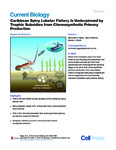Caribbean Spiny Lobster Fishery Is Underpinned by Trophic Subsidies from Chemosynthetic Primary Production
| dc.contributor.author | Higgs, Nicholas | |
| dc.contributor.author | Newton, J | |
| dc.contributor.author | Attrill, Martin | |
| dc.date.accessioned | 2017-04-27T12:54:26Z | |
| dc.date.available | 2017-04-27T12:54:26Z | |
| dc.date.issued | 2016-12-19 | |
| dc.identifier.issn | 0960-9822 | |
| dc.identifier.issn | 1879-0445 | |
| dc.identifier.uri | http://hdl.handle.net/10026.1/9129 | |
| dc.description | Data files are deposited with Figshare and are available at: https://dx.doi.org/10.6084/ m9.figshare.4225334. | |
| dc.description.abstract |
The Caribbean spiny lobster, Panulirus argus, is one of the most valuable fisheries commodities in the Central American region, directly employing 50,000 people and generating >US$450 million per year [1]. This industry is particularly important to small island states such as The Bahamas, which exports more lobster than any other country in the region [1]. Several factors contribute to this disproportionally high productivity, principally the extensive shallow-water banks covered in seagrass meadows [2], where fishermen deploy artificial shelters for the lobsters to supplement scarce reef habitat [3]. The surrounding seabed communities are dominated by lucinid bivalve mollusks that live among the seagrass root system [4, 5]. These clams host chemoautotrophic bacterial symbionts in their gills that synthesize organic matter using reduced sulfur compounds, providing nutrition to their hosts [6]. Recent studies have highlighted the important role of the lucinid clam symbiosis in maintaining the health and productivity of seagrass ecosystems [7, 8], but their biomass also represents a potentially abundant, but as yet unquantified, food source to benthic predators [9]. Here we undertake the first analysis of Caribbean spiny lobster diet using a stable isotope approach (carbon, nitrogen, and sulfur) and show that a significant portion of their food (∼20% on average) is obtained from chemosynthetic primary production in the form of lucinid clams. This nutritional pathway was previously unrecognized in the spiny lobster's diet, and these results are the first empirical evidence that chemosynthetic primary production contributes to the productivity of commercial fisheries stocks. | |
| dc.format.extent | 3393-3398 | |
| dc.format.medium | Print-Electronic | |
| dc.language | en | |
| dc.language.iso | en | |
| dc.publisher | Cell Press | |
| dc.subject | Bahamas | |
| dc.subject | chemosynthesis | |
| dc.subject | lobster | |
| dc.subject | seagrass | |
| dc.subject | stable isotope mixing models | |
| dc.subject | sulphur cycle | |
| dc.subject | symbiosis | |
| dc.subject | thiotrophy | |
| dc.subject | Animal Feed | |
| dc.subject | Animals | |
| dc.subject | Bacteria | |
| dc.subject | Caribbean Region | |
| dc.subject | Fisheries | |
| dc.subject | Food Chain | |
| dc.subject | Palinuridae | |
| dc.subject | Symbiosis | |
| dc.title | Caribbean Spiny Lobster Fishery Is Underpinned by Trophic Subsidies from Chemosynthetic Primary Production | |
| dc.type | journal-article | |
| dc.type | Journal Article | |
| dc.type | Research Support, Non-U.S. Gov't | |
| plymouth.author-url | https://www.webofscience.com/api/gateway?GWVersion=2&SrcApp=PARTNER_APP&SrcAuth=LinksAMR&KeyUT=WOS:000390666200034&DestLinkType=FullRecord&DestApp=ALL_WOS&UsrCustomerID=11bb513d99f797142bcfeffcc58ea008 | |
| plymouth.issue | 24 | |
| plymouth.volume | 26 | |
| plymouth.publisher-url | http://www.cell.com/current-biology/fulltext/S0960-9822(16)31260-X | |
| plymouth.publication-status | Published | |
| plymouth.journal | Current Biology | |
| dc.identifier.doi | 10.1016/j.cub.2016.10.034 | |
| plymouth.organisational-group | /Plymouth | |
| plymouth.organisational-group | /Plymouth/Faculty of Science and Engineering | |
| plymouth.organisational-group | /Plymouth/Faculty of Science and Engineering/School of Biological and Marine Sciences | |
| plymouth.organisational-group | /Plymouth/PRIMaRE Publications | |
| plymouth.organisational-group | /Plymouth/REF 2021 Researchers by UoA | |
| plymouth.organisational-group | /Plymouth/REF 2021 Researchers by UoA/UoA07 Earth Systems and Environmental Sciences | |
| plymouth.organisational-group | /Plymouth/Research Groups | |
| plymouth.organisational-group | /Plymouth/Research Groups/Marine Institute | |
| plymouth.organisational-group | /Plymouth/Users by role | |
| plymouth.organisational-group | /Plymouth/Users by role/Academics | |
| dc.publisher.place | England | |
| dcterms.dateAccepted | 2016-10-19 | |
| dc.identifier.eissn | 1879-0445 | |
| dc.rights.embargoperiod | No embargo | |
| rioxxterms.versionofrecord | 10.1016/j.cub.2016.10.034 | |
| rioxxterms.licenseref.uri | http://www.rioxx.net/licenses/all-rights-reserved | |
| rioxxterms.licenseref.startdate | 2016-12-19 | |
| rioxxterms.type | Journal Article/Review | |
| plymouth.oa-location | http://www.sciencedirect.com/science/article/pii/S096098221631260X?via=ihub |


